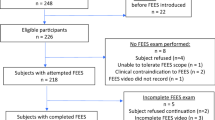Abstract
Aspiration pneumonia is a cause of mortality in the elderly. Evaluating swallowing function is important. Videofluoroscopy and flexible endoscopic evaluation of swallowing are comparable; however, observing all swallowing dynamics is impossible using the latter approach. We examined the significance of flexible endoscopic evaluation of swallowing using videofluoroscopy. Thirty-seven patients with dysphagia [70.0 ± 8.9 (range 49–84) years] were included. In random order, patients underwent videofluoroscopy with 10 cc contrast material, once without, and once with an endoscope inserted. Laryngeal elevation delay time, Penetration–Aspiration Scale score, and Pharyngeal Residue Severity Rating Scale score were evaluated. Laryngeal elevation delay time without or with endoscope insertion was similar (0.35 ± 0.16 s vs. 0.36 ± 0.16 s, P = 0.29). The Penetration–Aspiration Scale (3.59 ± 2.71 vs. 4.41 ± 2.85; P < 0.001) and Pharyngeal Residue Severity Rating Scale (0.97 ± 0.93 vs. 1.46 ± 1.10; P < 0.001) scores differed significantly. The cases that showed no aspiration without endoscope insertion showed greater aspiration with endoscope insertion, and the cases that did not show aspiration with an endoscope inserted also showed no aspiration without an endoscope. Flexible endoscopic insertion resulted in more severe aspiration and residue than non-insertion, as assessed using videofluoroscopy.


Similar content being viewed by others
References
Singh S, Hamdy S (2006) Dysphagia in stroke patients. Postgrad Med J 82:383–391
DeLegge MH (2002) Aspiration pneumonia: incidence, mortality, and at-risk populations. JPEN J Parenter Enteral Nutr 26:S19–S24 (discussion S24–S25)
Logemann JA, Rademaker AW, Pauloski BR, Ohmae Y, Kahrilas PJ (1998) Normal swallowing physiology as viewed by videofluoroscopy and videoendoscopy. Folia Phoniatr Logop 50:311–319
Lamgmore SE, Schatz K, Olson N (1991) Endoscopic and videofluoroscopic evaluation of swallowing and aspiration. Ann Otol Rhinol Laryngol 100:678–681
Logemann JA (1997) Role of the modified barium swallow in management of patients with dysphagia. Otolaryngol Head Neck Surg 166:335–338
Langmore SE, Schatz KM, Olsen N (1998) Fiberoptic endoscopic examination of swallowing safety: a new procedure. Dysphagia 2:216–219
Kelly AM, Drinnan MJ, Leslie P (2007) Assessing penetration and aspiration: how do videofluoroscopy and fiberoptic endoscopic evaluation of swallowing compare? Laryngoscope 117:1723–1727. doi:10.1097/MLG.0b013e318123ee6a
Kelly AM, Leslie P, Beale T, Payten C, Drinnan MJ (2006) Fibreoptic endoscopic evaluation of swallowing and videofluoroscopy: does examination type influence perception of pharyngeal residue severity? Clin Otolaryngol 31:425–432. doi:10.1111/j.1749-4486.2006.01292.x
Tabaee A, Johnson PE, Gartner CJ, Kalwerisky K, Desloge RB, Stewart MG (2006) Patient-controlled comparison of flexible endoscopic evaluation of swallowing with sensory testing (FEESST) and videofluoroscopy. Laryngoscope 116:821–825. doi:10.1097/01.mlg.0000214670.40604.45
Périé S, Laccourreye L, Flahault A, Hazebroucq V, Chaussade S, St Guily JL (1998) Role of videoendoscopy in assessment of pharyngeal function in oropharyngeal dysphagia: comparison with videofluoroscopy and manometry. Laryngoscope 108:1712–1716
Langmore SE (2001) Scoring a FEES examination. In: Langmore SE (ed) Endoscopic evaluation and treatment of swallowing disorders. Thieme, New York, pp 101–143
Miyaji H, Umezaki T, Adachi K et al (2012) Videofluoroscopic assessment of pharyngeal stage delay reflects pathophysiology after brain infarction. Laryngoscope 122:2793–2799. doi:10.1002/lary.23588
Rosenbek JC, Robbins JA, Roecker EB, Coyle JL, Wood JL (1996) A penetration-aspiration scale. Dysphagia 11:93–98
Pearson WG Jr, Molfenter SM, Smith ZM, Steele CM (2013) Image-based measurement of post-swallow residue: the normalized residue ratio scale. Dysphagia 28:167–177. doi:10.1007/s00455-012-9426-9
Dodds WJ, Logemann JA, Stewart ET (1990) Radiologic assessment of abnormal oral and pharyngeal phases of swallowing. AJR Am J Roentgenol 154:965–974
Dodds WJ, Stewart ET, Logemann JA (1990) Physiology and radiology of the normal oral and pharyngeal phases of swallowing. AJR Am J Roentgenol 154:953–963
Logemann JA (1983) Evaluation and treatment of swallowing disorders. College Hill Press, San Diego, pp 28–29
Park WY, Lee TH, Ham NS et al (2015) Adding endoscopist-directed flexible endoscopic evaluation of swallowing to the videofluoroscopic swallowing study increased the detection rates of penetration, aspiration, and pharyngeal residue. Gut Liver 9:623–628. doi:10.5009/qnl14147
Wu CH, Hsiao TY, Chen JC, Chang YC, Lee SY (1997) Evaluation of swallowing safety with fiberoptic endoscope: comparison with videofluoroscopic technique. Laryngoscope 107:396–401
Suiter DM, Moorhead MK (2007) Effects of flexible fiberoptic endoscopy on pharyngeal swallow physiology. Otolaryngol Head Neck Surg 137:956–958. doi:10.1016/j.otohns.2007.09.004
Author information
Authors and Affiliations
Corresponding author
Ethics declarations
Conflict of interest
The authors declare no conflicts of interest.
Ethical approval
All procedures performed in studies involving human participants were in accordance with the ethical standards of the institutional and/or national research committee and with the 1964 Helsinki declaration and its later amendments or comparable ethical standards.
Informed consent
Informed consent was obtained from all individual participants included in the study.
Additional information
Clinical Trial Registration: 23055.
Rights and permissions
About this article
Cite this article
Adachi, K., Umezaki, T. & Kikuchi, Y. Videoendoscopy worsens swallowing function: a videofluoroscopic study. A randomized controlled trial. Eur Arch Otorhinolaryngol 274, 3729–3734 (2017). https://doi.org/10.1007/s00405-017-4720-7
Received:
Accepted:
Published:
Issue Date:
DOI: https://doi.org/10.1007/s00405-017-4720-7




